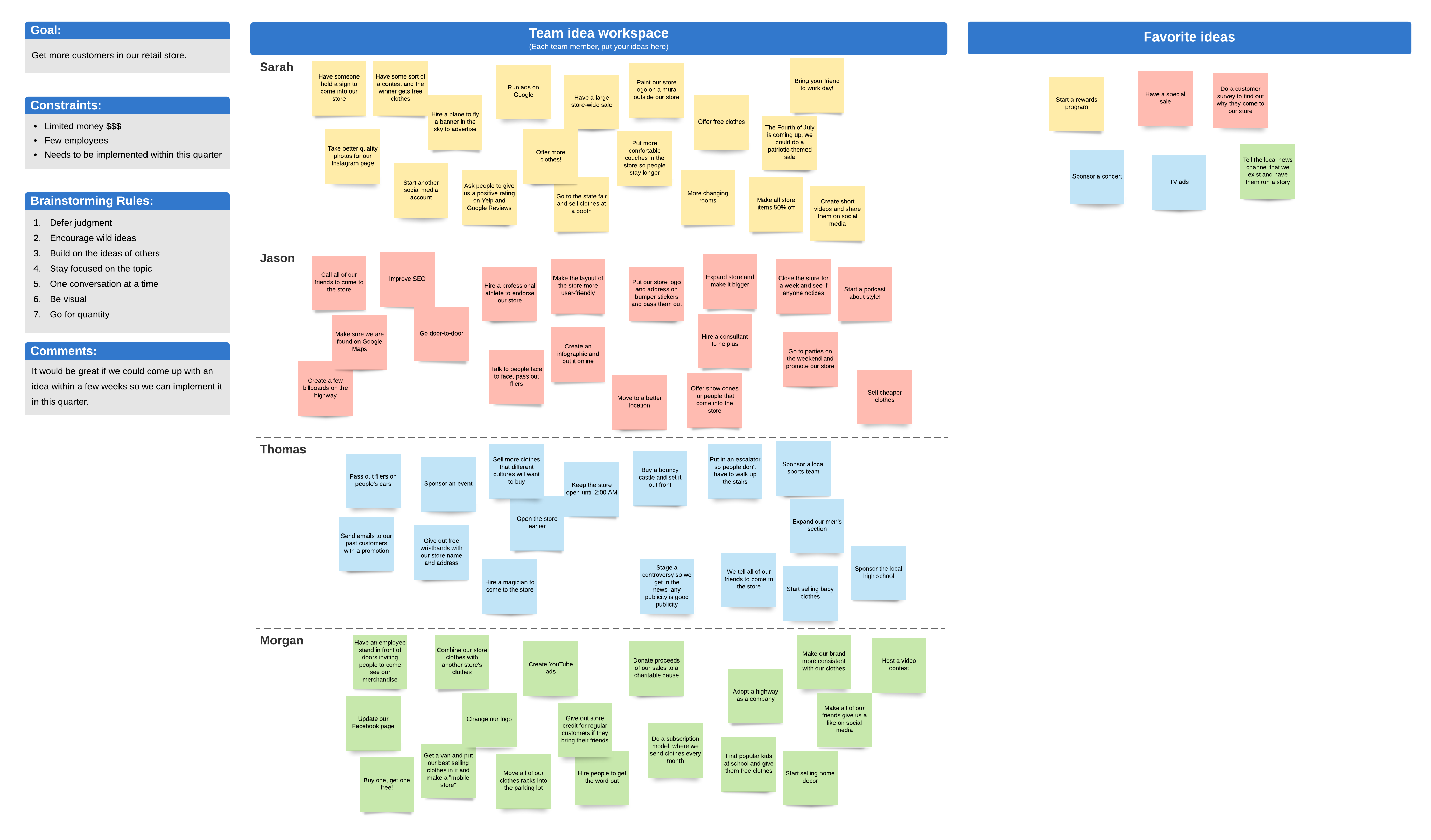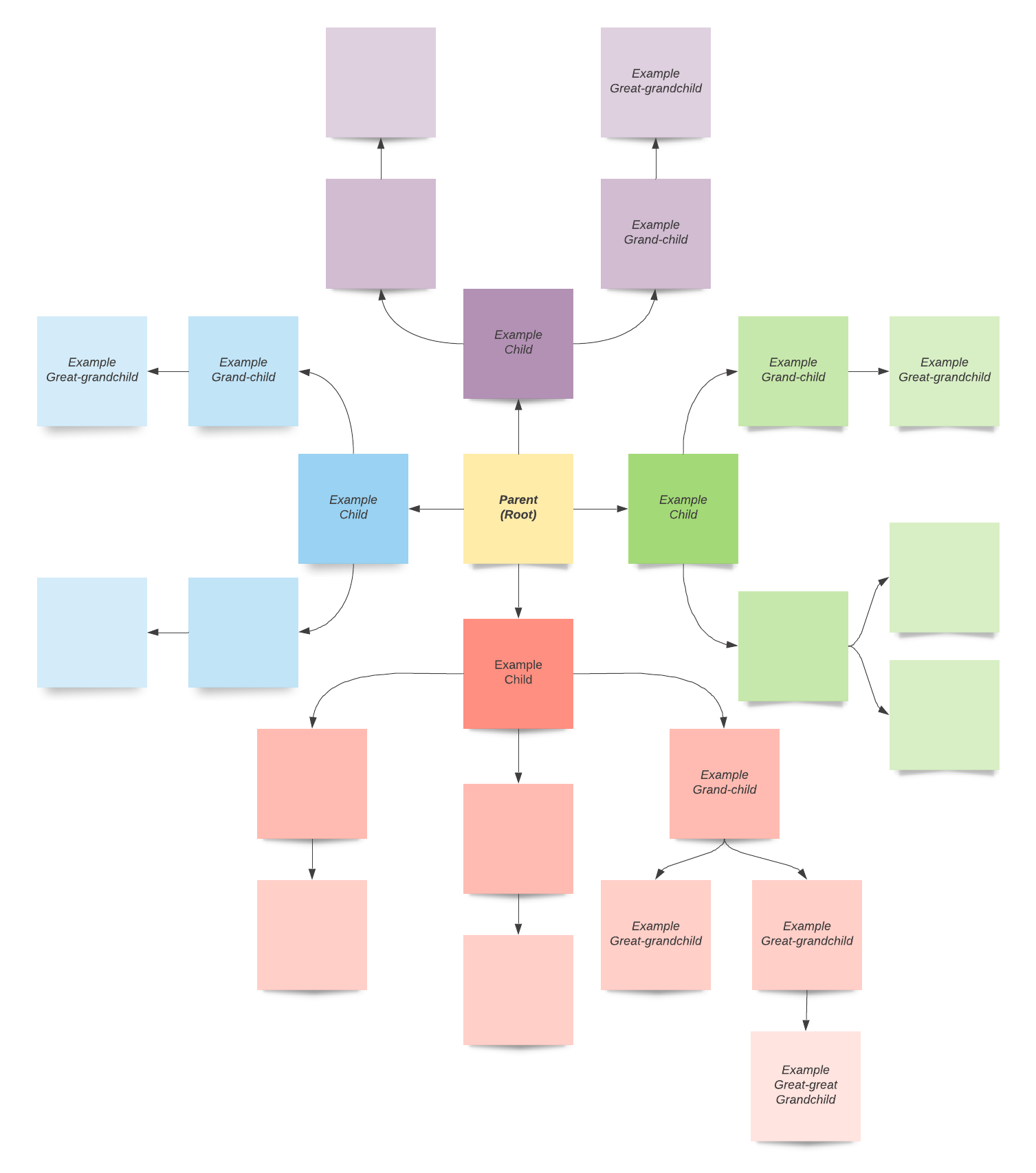
How to Run a Brainstorming Meeting
Lucid Content
Reading time: about 6 min
7 brainstorming meeting tips
- Keep it short.
- Keep it small.
- Clarify the problem to solve.
- Set a clear agenda.
- Have the group prepare individually.
- Facilitate the meeting.
- Consider alternatives to a meeting.
Have you ever sat through a brainstorming meeting where dozens of ideas were thrown at a wall for sixty minutes but nothing actually came of it? It’s frustrating to say the least. At the end of the meeting, everyone pats each other on that back and goes back to work—with no real solutions in sight.
Too often, this is how brainstorming sessions go. But it doesn’t have to be that way.
Brainstorming is one of the go-to methods for generating ideas and creating a collaborative environment. However, without the right preparation, leadership, and focus, a brainstorming meeting can quickly get derailed. Here’s how to run a brainstorming meeting that works.

Encourage collaboration and record your team's best ideas with our free brainstorming template.
Try it nowWhat is a brainstorming meeting?
The classic brainstorming meeting was developed in 1939 by the ad executive Alex Osborn. Looking for a way to improve the quality and quantity of ideas for ad campaigns within the team, Osborn began hosting group collaboration sessions. He discovered that when the team got together as a group, they were much more effective in coming up with original and creative ideas.
Today, brainstorming is popular across industries.
Benefits of brainstorming
Brainstorming is a great way to build unity among your team and flesh out ideas in a non-judgmental environment.
Besides simply generating new and unique ideas, brainstorming meetings bring people together where they can all contribute to the creative process. Often, this element of brainstorming becomes more valuable than the ideas shared in the actual meeting.
When a brainstorm session is well-run, team members leave feeling more comfortable and open with their peers, which can generate valuable collaboration and communication later on.
Of course, getting new ideas and workshopping creative solutions together is the core advantage of brainstorming. There are different brainstorming techniques, but when done well, those meetings can produce better and more diverse ideas than any one person could develop in the same amount of time.
7 brainstorming meeting tips
Despite its popularity, traditional brainstorming meetings do have their drawbacks and challenges. Poorly-run brainstorming sessions are like any other poorly-run office meetings—they waste time and energy.
In a traditional brainstorming session, only one person is speaking at a time, which can result in blocking—where other participants listening may follow the speaker’s train of thought and forget or dismiss their own ideas.
Additionally, brainstorms can lead to a phenomenon called groupthink. As people begin sharing their ideas, those around them start conforming to that line of thinking, ultimately limiting the diversity of the solutions discussed.
Brainstorming can also unfairly favor extroverts, who tend to be more comfortable speaking up in group settings and feed off the energy of the group. This situation hinders the valuable insights introverts may have to offer, as they may be more reluctant to chime in or struggle to think creatively on the spot.
Fortunately, these pitfalls can be avoided. Use these tips to keep your next brainstorming meeting on track and successful.
1. Keep it short
Shorter meetings help keep the group focused—when you have limited time to get all the ideas out there, people tend to stay on track. Aim for just 15-30 minutes. A shorter meeting means your group will need to come prepared and that you’ll need a clear agenda (more on that later).
Pro tip: Pay attention to when you schedule the meeting as well. Late afternoon tends to be when people are more sluggish and mentally fatigued—and watching the clock until they can go home. Not a great recipe for innovation.
2. Keep it small
Just like there can be too many cooks in the kitchen, there can be too many people in a brainstorming session. Keep the group small—ideally no more than 10 people. That way, everyone has an opportunity to be heard and more constructive conversations can flow.
Choose your group wisely. Invite a diverse team of people so you can uncover new ideas and approaches to a problem.
Don’t invite people who are too far removed from the issue—you want to encourage dialogue and buy-in for this process. If the issue isn’t relevant to a person, or they are too far removed from the issue, they will have a harder time contributing meaningfully to the discussion.
3. Clarify the problem to solve
The best ideas come when the group understands exactly what problem they are trying to solve. To clarify that problem, you might want to offer a prompting question, such as “What are ways we can increase sales next quarter?”
Then, set boundaries on the solutions. In other words, what are the constraints or requirements for the solution(s)? For example, the solution might have to fit within a certain budget. The more constraints you put on the solutions, the more focused the ideas will be.
Give the group this information before the meeting (at least 1-2 days ahead of time), as well as any other contextual information they need to further understand the problem and goals for the session.
4. Set a clear agenda
Meetings without an agenda tend to veer off track quickly. Keep the group focused by creating (and sticking to) an agenda. Send out the agenda ahead of time so each person knows what to expect and can prepare.
5. Have the group prepare individually
To avoid groupthink and ensure each person has a chance to contribute equally, invite the group to prepare for the brainstorming meeting individually.
Research has shown that people tend to produce better ideas when they think alone first. Then, when the group meets together with their prepared ideas, they are able to collaborate more effectively to identify and develop the best solutions.
6. Facilitate the meeting
A good facilitator is crucial to the success of your brainstorming meeting. A facilitator’s job is to guide the discussion and keep the group on track by:
- Redirecting the conversation if it trails off or goes off-topic.
- Clarifying and enforcing the rules of the brainstorm.
- Ensuring each person has a chance to contribute.
- Explaining next steps at the end of the meeting.
Having a facilitator ensures the group stays focused and time is well spent.
7. Consider alternatives to a meeting
Traditional brainstorming meetings are held in person with a whiteboard or sticky notes.
But there are many different ways to run an effective brainstorming session.
For example, remote or distributed teams can use cloud-based solutions like Lucidchart's brainstorming software to map out ideas, leave feedback, and visualize their plan of action. Other alternatives include email, online chat, or anonymous submissions to the group leader. Use the tools and methods that work best for your team’s culture, preferences, and work styles.
At the end of the day, it is less important what the brainstorming looks like than whether it met the needs and goals of the group.
If you're ready to get started, sign up for a free Lucidchart account or choose a template below to begin brainstorming your next big idea.


About Lucidchart
Lucidchart, a cloud-based intelligent diagramming application, is a core component of Lucid Software's Visual Collaboration Suite. This intuitive, cloud-based solution empowers teams to collaborate in real-time to build flowcharts, mockups, UML diagrams, customer journey maps, and more. Lucidchart propels teams forward to build the future faster. Lucid is proud to serve top businesses around the world, including customers such as Google, GE, and NBC Universal, and 99% of the Fortune 500. Lucid partners with industry leaders, including Google, Atlassian, and Microsoft. Since its founding, Lucid has received numerous awards for its products, business, and workplace culture. For more information, visit lucidchart.com.
Related articles
14 remote team building ideas for the distributed office
How can you bridge the virtual gap and bring your team together? Try these virtual team building games to increase trust, collaboration, and employee engagement from anywhere.
How to brainstorm: 4 ways to get the creative juices flowing
Brainstorming can promote problem-solving and innovative thinking to bring the best ideas forward. Follow these four steps and learn how to brainstorm ideas like a pro.
